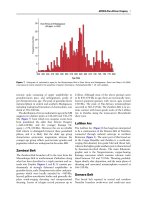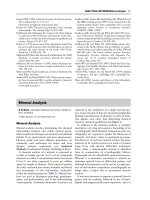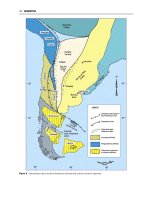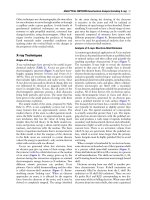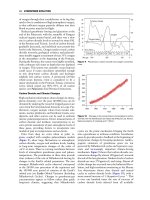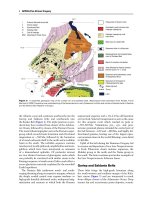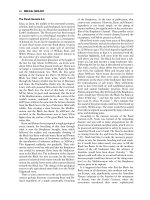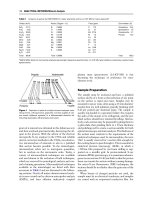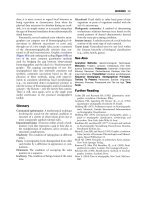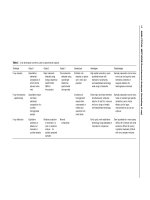Encyclopedia of geology, five volume set, volume 1 5 (encyclopedia of geology series) ( PDFDrive ) 2860
Bạn đang xem bản rút gọn của tài liệu. Xem và tải ngay bản đầy đủ của tài liệu tại đây (57.55 KB, 1 trang )
TECTONICS/Earthquakes 323
Table 2 The modified Mercalli (MSK) intensity scale
Intensity
I
II
III
IV
V
VI
VII
VIII
IX
X
XI
XII
Effects
Felt rarely. Sometimes dizzyness and nausea. Birds and animals uneasy. Trees, structures, liquids sway.
Felt indoors by a few, especially on upper floors. Delicately suspended objects swing.
Felt indoors, especially on upper floors by several people. Usually rapid vibration as if a lightly loaded lorry passing.
Hanging objects and standing motor cars rock slightly.
Felt indoors by many and outside by a few. Some awakened. No one usually frightened. Sensation of heavy object striking
building. Vibration as of heavy lorries passing. Crockery, windows, doors rattle. Walls and frames creak. Hanging
objects and standing motor cars sway.
Felt indoors by almost everyone, outdoors by most people. Many awakened, a few frightened and run outdoors. Buildings
tremble. Crockery and windows sometimes break. Pictures and doors clatter. Small objects move. Some liquids spilt.
Clocks stopped. Trees shaken. Animals anxious.
Felt by all indoors and outdoors. Many frightened, some alarmed. All awakened. People, trees, bushes shaken. Liquids
set in motion. Small bells ringing. Crockery broken. Plaster cracks and falls. Books and vases fall over. Some furniture
moved. Domestic animals try to escape. Minor landslides on steep slopes.
All frightened, run out of doors, general alarm. Some people thrown to ground. Trees shaken quite strongly. Waves and
mud stirred up in lakes. Sandbanks collapse. Large bells ring. Suspended objects quiver. Much damage to badly
constructed buildings and old walls. Slight damage to well built buildings. Chimneys crack. Much plaster, tiles, loose
bricks fall. Heavy furniture overturned. Concrete ditches damaged.
Alarm approaches panic. Vehicle drivers disturbed. Trees broken and shaken. Sand and mud spurt from the ground.
Marked changes to springs and wells. Much damage to ordinary and older buildings. Walls, pillars, chimneys, towers,
statues, gravestones crack and fall. Very heavy furniture overturned.
General panic. Ground cracked open (10 cm). Much damage to structures built to withstand earthquakes. Frequent partial
or total collapse of other buildings. In reservoirs, underground pipes broken. Buildings dislodged from foundations,
rock falls.
Widely cracked ground, fissures up to 1 m wide. Frequent river bank and coastal landslides and shifted sands. Water
levels change. Water thrown onto riversides. Serious damage to dams, embankments, bridges. Severe damage to well
built wooden structures. Masonry structures destroyed along with their foundations. Rails bent. Open cracks or waves
on roads. Pipes torn apart.
Widespread serious ground disturbance, broad fissures, landslips, landslides. Muddy water spurts upward. Tsunamis
develop. Severe damage to all wooden structures. Great damage to dams. Few masonry structures remain upright.
Pillars of bridges and viaducts wrecked. All pipelines wrecked. Rails badly bent.
Total damage to all constructions. Great disturbance to ground with many shearing cracks. Many landslides on slopes,
rockfalls common, rock masses dislocated, water channels altered and dammed. Ground surface waves like water and
ground remains undulating. Objects thrown into the air.
the case of the Cairo earthquake in 1992 and the
Killari, central India, earthquake in 1993. In the
case of the Cairo earthquake, poorly constructed
extra storeys had been added to moderate-rise housing. In Killari, stone-built low-rise houses were poorly
constructed (Figure 10). In the catastrophic Bam
earthquake of December 2003, the mud bricks of
the low-rise dwellings crumbled and collapsed, leaving few air spaces to allow buried victims to breathe;
another factor responsible for the scale of the fatalities was the fact that all the dwellings in southern
Iran have basements cooled by wind towers designed
for the sweltering summer heat, and many victims
would have been asleep in them.
Some of the most devastating historic and recent
earthquakes are listed in Table 3.
Where cities are situated in plate-boundary zones
the effects are most disastrous. The San Francisco
earthquake of 1906 (Figure 11) provides an example
of this. The Kobe earthquake of 1995, in which the
financial loss was US $200 billion, occurred in a city
that experiences a tremor every few days. An analysis
of the locations of 100 of the largest cities in the
world, which accommodate 10% of the global population, shows that they can expect to experience an
earthquake of intensity VI or more on the MSK scale
within 50 years.
The earthquake hazard extends beyond high-risk
cities such as those sited on plate boundaries. Entire
countries may be at quite low risk, yet have some
vulnerability. The UK is a low-risk country, and earthquakes of more than magnitude 5.5 are extremely
unlikely (Figure 12). Charles Davidson published a
list of 1191 recorded shocks in Britain between AD
974 and AD 1924. In Lincoln in 1185, ‘‘great stones
were rent; houses of stone fell; the metropolitan
church of Lincoln was rent from top to bottom’’ and
there is a similar report from the cathedral city of
Wells in 1248. Two apprentices were killed in London
in 1580 as a result of an earthquake in the Dover
Straits. The Colchester earthquake in 1884 (magnitude 4.7) peaked in intensity near the epicentre (between Pelden and Langenhoe) (Figure 13) at MSK
VIII and caused widespread damage, which was
